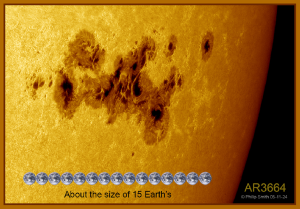Near X-Class Solar Flare Triggers M9.5 Eruption, Resulting in Pacific Radio Blackouts
2nd May 2024
On Tuesday, 30 April, a highly intense solar flare erupted from the sun, causing extensive radio blackouts across the Pacific region. The flare reached its peak and subsided within a period of 12 minutes.
Solar flares, eruptions from the sun’s surface, emit intense bursts of electromagnetic radiation. They occur when magnetic energy builds up in the solar atmosphere and is subsequently released.
Understanding Solar Flares and Their Classification
Solar flares are classified by size into lettered groups, with X-class flares being the most potent. Following the X-class are M-class flares, which are approximately ten times less powerful. They are succeeded by C-class flares, which are about ten times weaker than the M-class. Subsequently, there are B-class flares, ten times less intense than C-class, and A-class flares, ten times less potent than B-class.
In each class, numerical values from 1 to 10 (and beyond for X-class flares) denote the relative strength of a flare. The recent flare on April 30 was registered at M9.53, as reported by Spaceweatherlive.com, and measured by NASA’s GOES-16 satellite, placing it just slightly below the threshold of an X-class solar flare.

Impact of M9.53 Solar Flare on Pacific Radio Communication
Shortwave radio blackouts, such as the one observed over the Pacific, are frequent occurrences shortly after potent solar flare eruptions. This is attributed to the intense pulse of X-rays and extreme ultraviolet radiation emitted during the event. Traveling at the speed of light, this radiation ionizes the upper layers of Earth’s atmosphere upon reaching our planet.
The ionization process creates a denser environment through which high-frequency shortwave radio signals must traverse for long-distance communication. When radio waves interact with electrons in these ionized layers, they experience increased collisions, resulting in energy loss. The National Oceanic and Atmospheric Administration (NOAA) Space Weather Prediction Center notes that this phenomenon can cause degradation or complete absorption of radio signals.
Solar activity is intensifying as we near solar maximum, the pinnacle of solar activity within the sun’s approximately 11-year cycle, marked by the frequency of sunspots. Despite the considerable presence of sunspots on the sun’s surface at present, our star has remained relatively tranquil in recent weeks. However, that has changed. A nearly X-class solar flare erupted from the sunspot region AR3654, marking the most potent eruption observed from this region thus far.
Role of NASA and NOAA in Monitoring and Warning of Solar Activity
Powerful solar flares can substantially impact spacecraft, satellites, and ground-based technologies. Traveling at the speed of light, they offer little advance warning before striking. Hence, the crucial role of organizations like NASA, NOAA, and the U.S. Air Force Weather Agency (AFWA) in maintaining close surveillance of the sun cannot be overstated.
NASA and NOAA are at the forefront of monitoring and warning about solar flare activity. Equipped with advanced technology and expertise, they issue timely alerts to technology and infrastructure sectors susceptible to solar flare activity. Such alerts enable the implementation of appropriate precautions in anticipation of potentially harmful space weather events.







Thank you for your comment! It will be visible on the site after moderation.